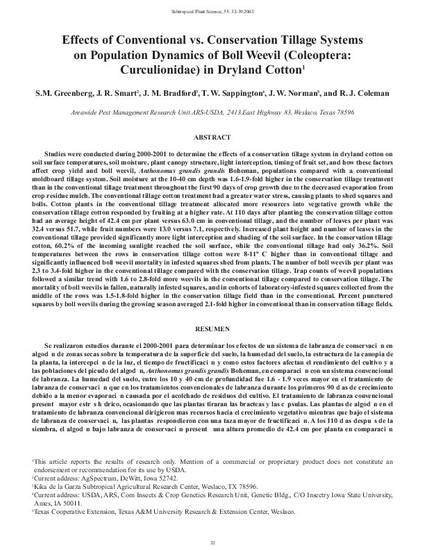
Studies were conducted during 2000-2001 to determine the effects of a conservation tillage system in dryland cotton on soil surface temperatures, soil moisture, plant canopy structure, light interception, timing of fruit set, and how these factors affect crop yield and boll weevil, Anthonomus grandis grandis Boheman, populations compared with a conventional moldboard tillage system. Soil moisture at the 10-40 cm depth was 1.6-1.9-fold higher in the conservation tillage treatment than in the conventional tillage treatment throughout the first 90 days of crop growth due to the decreased evaporation from crop residue mulch. The conventional tillage cotton treatment had a greater water stress, causing plants to shed squares and bolls. Cotton plants in the conventional tillage treatment allocated more resources into vegetative growth while the conservation tillage cotton responded by fruiting at a higher rate. At 110 days after planting the conservation tillage cotton had an average height of 42.4 cm per plant versus 63.0 cm in conventional tillage, and the number of leaves per plant was 32.4 versus 51.7, while fruit numbers were 13.0 versus 7.1, respectively. Increased plant height and number of leaves in the conventional tillage provided significantly more light interception and shading of the soil surface. In the conservation tillage cotton, 60.2% of the incoming sunlight reached the soil surface, while the conventional tillage had only 36.2%. Soil temperatures between the rows in conservation tillage cotton were 8-11º C higher than in conventional tillage and significantly influenced boll weevil mortality in infested squares shed from plants. The number of boll weevils per plant was 2.3 to 3.4-fold higher in the conventional tillage compared with the conservation tillage. Trap counts of weevil populations followed a similar trend with 1.6 to 2.8-fold more weevils in the conventional tillage compared to conservation tillage. The mortality of boll weevils in fallen, naturally infested squares, and in cohorts of laboratory-infested squares collected from the middle of the rows was 1.5-1.8-fold higher in the conservation tillage field than in the conventional. Percent punctured squares by boll weevils during the growing season averaged 2.1-fold higher in conventional than in conservation tillage fields.
Available at: http://works.bepress.com/thomas_sappington/24/

This article is from Subtropical Plant Science 55 (2003): 32.